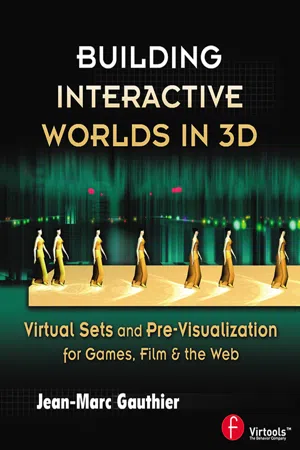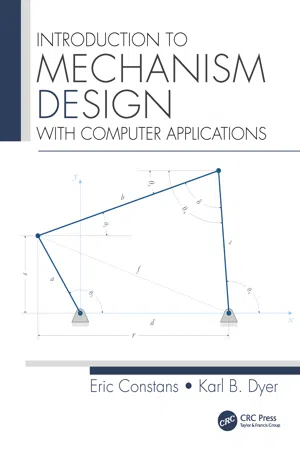Technology & Engineering
Kinematics Engineering
Kinematics engineering involves the study of motion, including the position, velocity, and acceleration of objects. It focuses on understanding and analyzing the movement of various mechanical systems, such as robots, vehicles, and machinery. By applying principles of physics and mathematics, kinematics engineering plays a crucial role in designing and optimizing the performance of these systems.
Written by Perlego with AI-assistance
Related key terms
3 Key excerpts on "Kinematics Engineering"
- eBook - ePub
- D. Gordon E. Robertson, Graham E. Caldwell, Joseph Hamill, Gary Kamen, Saunders Whittlesey(Authors)
- 2013(Publication Date)
- Human Kinetics(Publisher)
PART IKINEMATICSKinematics is the study of motion without regard to causes. Studying human motion in the past was a time-consuming, laborious, and expensive task because cinematography was employed and manual methods were needed to extract the trajectories of body parts from the film. Advances in technology have automated much of the processes of capturing motion data electronically and then extracting the two- or three-dimensional trajectories. Such technology is now commonplace in the motion picture industry, but biomechanists use additional software to obtain time derivatives of the various trajectories or combine the trajectories to reconstruct the motions of body segments and joints so that differences in motion patterns can be readily identified. Kinematics is also the first step to analyses by inverse dynamics (covered in part II ) that estimate the causes of the motion. In this part, chapter 1 outlines how to record two-dimensional kinematics electronically, photographically, and videographically and how to extract digital data from the recordings. Chapter 2 outlines the additional mathematics and processing needed for three-dimensional kinematics. Note that chapter 12 outlines data smoothing techniques that are also important to the valid processing of kinematics, particularly accelerations. Several of the appendixes also have information concerning electronics (appendix C ) and mathematical principles (appendixes D and E) that are required for data collection and analysis in kinematics. Note that text in boldface is a concept described in the glossary at the end of the book.Passage contains an image
Chapter 1Planar KinematicsD. Gordon E. Robertson and Graham E. CaldwellK inematics - eBook - ePub
Building Interactive Worlds in 3D
Virtual Sets and Pre-visualization for Games, Film & the Web
- Jean-Marc Gauthier(Author)
- 2013(Publication Date)
- Routledge(Publisher)
C H A P T E R 4Kinematics
1 IntroductionKinematics, the fourth dimension of virtual spaces, goes beyond visual relationships between objects in motion. Object manipulations that take place in a dynamic space may involve obstacles, fixed objects, physics, hinges, and springs. Spatial relationships between moving objects can extend through space and time and affect many more levels than the sum of each moving object. For example, the motion of a ball depends on multiple parameters including elasticity of the ball, friction of the floor, and obstacles located on the trajectory of the ball. This chapter explains how to set objects in motion and how to create dynamic relationships between objects.1.1 KinematicsKinematics shows how objects move and how the space around them is used during motion. We can look at the motion of objects as a process that encompasses space and the context of these objects in the virtual space. For example, an object rolling on a terrain can set other objects in motion and therefore change the topology of the space. The first section of this chapter covers simple manipulations in virtual space like moving an object, grouping several objects, reshaping, bending, and cloning. The second section focuses on complex manipulations of objects using several motions played in sequence. The third section about motion planning shows how autonomous agents can plan their movements before starting to move.Designers need to know which motion techniques are more appealing to viewers. The perception of motion is very subjective. Viewers’ eyes are quick to judge the qualities of the movement even before they see the details of the moving object. Viewers can intuitively break a simple motion into several subanimations. For example, viewers looking at the animation of a merry-go-round spinning inside a virtual garden can detect many components of the movement. They can notice when it moves quickly or slowly or if the center of rotation is slightly off. The eye can automatically detect something unusual and question the stability of the animation. The same goes for character animation. A small twitch in a character’s walk can become so visible that the viewer may become frustrated with the movement of that virtual character. - eBook - ePub
Introduction to Mechanism Design
with Computer Applications
- Eric Constans, Karl B. Dyer(Authors)
- 2018(Publication Date)
- CRC Press(Publisher)
1Introduction to Kinematics
1.1 Introduction to Mechanical Design
The subject of this textbook is mechanical design and analysis. While most people have at least a vague idea of what the word “design” means, in this text we are mainly interested in two definitions [1 ]:Design: transitive verb 1. To make preliminary sketches of; sketch a pattern or outline for; plan. 2. To plan and carry out, esp. by artistic arrangement or in a skillful way. … intransitive verb 8. the arrangement of parts, details, form, color, etc. so as to produce a complete and artistic unitThe goal of the text is to give the reader a set of computational tools to design and analyze mechanisms to achieve specific goals. A mechanism is a collection of links and joints designed in such a way as to create a desired motion output. One link of a mechanism is “grounded,” that is, fixed to some reference frame, and we are commonly interested in finding the motion of the remaining links. Some examples of mechanisms are windshield wiper blades, the crankshaft/connecting rod/piston assembly in a car engine, certain types of hinges, mechanical watches and clocks, etc. Another excellent example of a mechanism, or linkage, is the human body. Each segment of the body can be modeled as a link, and the segments are connected through pin joints (the elbow) or spherical joints (the shoulder). By modeling the body in this way, biomechanical engineers can deduce the forces and moments present at the joints by analyzing the motion of the body with motion capture techniques.Scientists, mathematicians, and engineers have studied mechanisms since the 1700s. Until very recently, all mechanism analysis was performed graphically, that is, with drafting tools. These tools have been superseded in modern times by computational tools such as CAD software, which make it possible to analyze several trial designs very quickly to find a solution. Computers have also made “linkage design optimization” possible; that is, finding the dimensions of a linkage that traces out a desired path.
Index pages curate the most relevant extracts from our library of academic textbooks. They’ve been created using an in-house natural language model (NLM), each adding context and meaning to key research topics.


